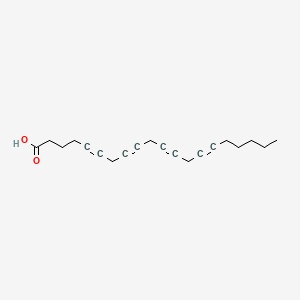| Stenson WF and Parker CW |
Monohydroxyeicosatetraenoic acids (HETEs) induce degranulation of human neutrophils. |
1980 |
J. Immunol. |
pmid:6767782
|
| Lei J et al. |
Peroxisome proliferator-activated receptor α and γ agonists together with TGF-β convert human CD4+CD25- T cells into functional Foxp3+ regulatory T cells. |
2010 |
J. Immunol. |
pmid:21057085
|
| Dinarello CA et al. |
Role of arachidonate metabolism in the immunoregulatory function of human leukocytic pyrogen/lymphocyte-activating factor/interleukin 1. |
1983 |
J. Immunol. |
pmid:6401308
|
| Rand TH et al. |
Arachidonic acid metabolism in the murine eosinophil. III. Effect of nonsteroid anti-inflammatory drugs on lymphokine-directed eosinophil migration in vivo. |
1983 |
J. Immunol. |
pmid:6401785
|
| Yecies LD et al. |
Slow reacting substance (SRS) from ionophore A23187-stimulated peritoneal mast cells of the normal rat. II. Evidence for a precursor role of arachidonic acid and further purification. |
1979 |
J. Immunol. |
pmid:376731
|
| Regal JF and Pickering RJ |
C5a-induced tracheal contraction: effect of an SRS-A antagonist and inhibitors of arachidonate metabolism. |
1981 |
J. Immunol. |
pmid:7451973
|
| Cheung K et al. |
The origin of chemiluminescence produced by neutrophils stimulated by opsonized zymosan. |
1983 |
J. Immunol. |
pmid:6687603
|
| Shipman PM et al. |
Relation between arachidonic acid metabolism and development of thymocytes in fetal thymic organ cultures. |
1988 |
J. Immunol. |
pmid:2895793
|
| Falkenhein SF et al. |
Effect of the 5-hydroperoxide of eicosatetraenoic acid and inhibitors of the lipoxygenase pathway on the formation of slow reacting substance by rat basophilic leukemia cells; direct evidence that slow reacting substance is a product of the lipoxygenase pathway. |
1980 |
J. Immunol. |
pmid:6103910
|
| Watanabe-Kohno S and Parker CW |
Role of arachidonic acid in the biosynthesis of slow reacting substance of anaphylaxis (SRS-A) from sensitized guinea pig lung fragments: evidence that SRS-A is very similar or identical structurally to nonimmunologically induced forms of SRS. |
1980 |
J. Immunol. |
pmid:6104681
|
| Farnam J et al. |
Complement- and IgE-mediated release of histamine from basophils in vitro. V. Differential effects of drugs modulating arachidonic acid metabolism. |
1985 |
J. Immunol. |
pmid:2578053
|
| Taylor AS et al. |
Inhibition of cytotoxic T lymphocyte-mediated lysis by ETYA: effect independent of arachidonic acid metabolism. |
1985 |
J. Immunol. |
pmid:2981259
|
| Almawi WY et al. |
Partial mediation of glucocorticoid antiproliferative effects by lipocortins. |
1996 |
J. Immunol. |
pmid:8955167
|
| Farber HW et al. |
Generation of, lipid neutrophil chemoattractant activity by histamine-stimulated cultured endothelial cells. |
1986 |
J. Immunol. |
pmid:3760577
|
| Sutton MB et al. |
Regulation of the synthesis of the third component of complement and factor B in cord blood monocytes by lipopolysaccharide. |
1986 |
J. Immunol. |
pmid:3003195
|
| Burrall BA et al. |
Enzymatic properties of the 15-lipoxygenase of human cultured keratinocytes. |
1988 |
J. Invest. Dermatol. |
pmid:2459258
|
| Ziboh VA et al. |
Biosynthesis of lipoxygenase products by enzyme preparations from normal and psoriatic skin. |
1984 |
J. Invest. Dermatol. |
pmid:6094672
|
| Ingraham LM et al. |
Relation of respiratory burst and arachidonate metabolism during phagocytosis by guinea pig alveolar macrophages. |
1982 |
J. Lab. Clin. Med. |
pmid:6281348
|
| Lew DB et al. |
Role of endogenously derived leukotrienes in the regulation of lysosomal enzyme expression in macrophages exposed to beta 1,3-glucan. |
1991 |
J. Leukoc. Biol. |
pmid:1825502
|
| Goodman RP and Brash AR |
Measurement of 5,8,11, 14-icosatetraynoic acid in plasma by gas-liquid chromatography. |
1981 |
J. Lipid Res. |
pmid:7240980
|
